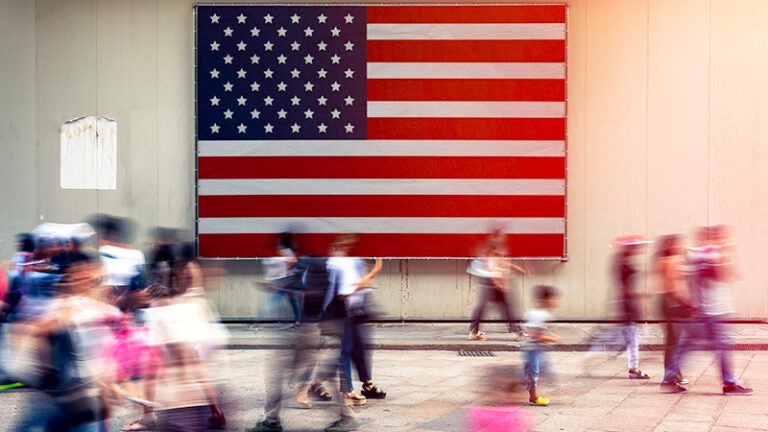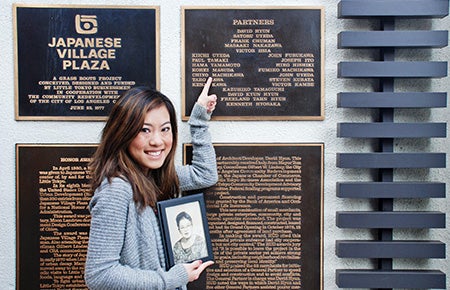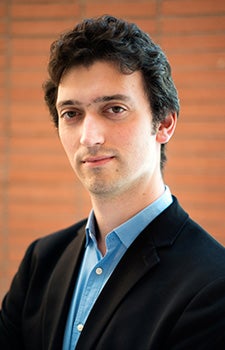
Stories of Immigration
A plaque near a series of shops on First Street in Little Tokyo stands as a reminder of family history for one USC Dornsife student.
It honors the area’s original shopkeepers, including Chiyo Machikawa, a jewelry store owner. She was the great grandmother of Natalie Yee, a junior studying psychology. Machikawa was denied citizenship for years, even after she had married a Japanese-American and had crossed the ocean to join him.
“My great grandmother faced many barriers obtaining citizenship,” says Yee, “and she faced a lot of discrimination.”
Yee retraced her great grandmother’s journey to United States citizenship through interviews with her uncle, and retold it in an essay for a new Fall undergraduate course taught by Associate Professor of History and Spatial Sciences Nathan Perl-Rosenthal: HIST 210gw, “How to be an American: Global Histories of U.S. Citizenship.”
A timely undertaking
The Fall semester course drew high interest from students. Perl-Rosenthal challenged them to examine the history of immigration and citizenship policies in the U.S. by looking back through the stories of their own families.
He could not have chosen a better time for launching the course.
Soon after President Donald Trump settled into the White House, his administration began to shift immigration policy, attempting to ban immigrants from largely Muslim nations and later separating thousands of migrant children from their parents at the United States-Mexico border.
Trump even suggested he could abolish the Constitutional guarantee, embedded in the 14th Amendment, that confers citizenship on anyone born on U.S. soil. And his promise to build a multibillion-dollar border wall led to the longest shutdown of the federal government in history.
“I had written a book that talks about the early period of U.S. citizenship, and that eventually got me wondering: How would you talk about these issues with students?” says Perl-Rosenthal, whose book Citizen Sailors: Becoming American in the Age of Revolution (Belknap Press, 2015), demonstrates how American sailors of the revolutionary era played a significant role in the formation of modern notions of nationality in the U.S.
“When I wrote it, it seemed relevant and the issues of citizenship and immigration were clearly on the horizon, so I wondered how I could teach this to students. I wanted to give students a civics lesson — to get them thinking about how the community of Americans came to be,” Perl-Rosenthal says.
As part of their research, the USC Dornsife students interviewed family members, friends or acquaintances who were immigrants or who knew their family’s immigration story in sharp detail. Families shared painful experiences of citizenship denial, or the complications that slow immigration for even those who are most desperate, trying to flee war-torn areas.
The stories of citizenship granted or denied, compiled and retold by students for their final essays in Perl-Rosenthal’s course, demonstrate not only the evolution of citizenship and immigration policies in the country, but the enduring trauma caused when citizenship rights are stripped away or held out of reach, and for some, the joy of citizenship when it is finally granted.
For those who could not access a family history, Perl-Rosenthal coordinated with a friend, Joel Snyder, a high school social studies teacher at Green Dot Public Schools in South Los Angeles. Snyder asked his own students, many of whose families had immigrated to the U.S. in recent decades, to document their immigration stories, then shared them with Perl-Rosenthal’s class.
Students in the USC Dornsife course have shared their essays, and the following stories are based on two of those essays.
From Japan to Boyle Heights

Student Natalie Yee holds a photo of her great grandmother Chiyo Machikawa and points to a 1977 plaque commemorating Machikawa and other original shopkeepers of Little Tokyo’s Japanese Village Plaza in Los Angeles. Photo by Emily Gersema
With the promise of American citizenship, Yee’s great grandmother Machikawa left her home in Takamatsu, Japan, to marry Koji Miyazaki, an L.A. watch repairman who had pursued her because she was known as the most intelligent woman in her school.
Chiyo was the salutatorian of her college class, agreed to his proposal and immigrated to the U.S. in 1918 to join her new husband.
Her great grandmother’s immigration was allowed by the Gentleman’s Agreement of 1907, Yee says. The agreement, brokered by President Theodore Roosevelt, allowed Japanese to immigrate but not obtain citizenship or own property. In exchange, Japan agreed to discourage immigration of its citizens to the U.S.
Her great grandmother Chiyo divorced from her husband in 1929 and then remarried in 1936. Together, she and her new husband set about raising four children at a home in Boyle Heights. Then, World War II erupted.
Like many Japanese and Japanese-Americans, Chiyo and her family were forced into an internment camp. She had to leave behind a jewelry store in Little Tokyo she operated and hoped to own once U.S. law changed and allowed her to become a citizen. Chiyo entrusted the family’s home to a daughter until she and her family were allowed to return home in 1945. “Luckily, (Chiyo) still had the home because it was under the management of her daughter, who was an American citizen,” Yee writes.
Chiyo was granted citizenship in 1952, after the McCarran-Walter Act ended Asian exclusion from U.S. immigration. She could finally own property.
Yee says that in some ways, immigration policy isn’t very different today. Certain groups of immigrants continue to face discrimination, with their fate determined largely by laws and policies that result in inequitable access to citizenship.
A complicated family history
USC Dornsife junior Lizzy Patton’s best friend from high school is Hannah Vasquez, who came to live in her father’s hometown of L.A. in 2002.
Vasquez’s father was a member of the United Nations’ peacekeeping forces that were assigned to Bosnia and Herzegovina, whose independence from Yugoslavia in 1992 led to a brutal war, genocide and occupation. Until her teens, though, Vasquez believed she was a mix of Bosnian and Spanish, a myth perpetuated by her family to guard against racist attacks, says Patton, who is majoring in biological sciences.
She did not learn until her teens that her paternal side was Mexican-American.
When Vasquez’s extended family began the process of immigrating to the U.S., they did not immigrate all at once together due to restrictions outlined in the Immigration Act of 1990. In addition, the family began their move a year after the terrorist attacks of Sept. 11, 2001 — a fragile period for immigrants such as the Bosnian side of Vasquez’s family, who were Muslims and who had survived genocide in Yugoslavia.
Patton says her friend’s grandparents had to immigrate separately, three years after Vasquez and her parents moved here. Vasquez’s older brother also was forced to immigrate later.
“This, especially after the stress of moving away from their community in Bosnia, deeply hurt Hannah and her mother,” Patton says.
As it turns out, the Vasquez family had, two generations before Hannah, immigrated to the U.S. from Mexico in the 1950s. The family has no record of how her father’s parents made the journey. Vasquez’s father believes that they obtained work visas; her grandfather found a job at a factory in the garment district.
Patton notes that the racial biases built into immigration law, as well as racism, affect whether or not immigrants like her friend develop a sense of belonging in the U.S.
“While Hannah speaks Bosnian, was born in Bosnia, and lives in a Bosnian household, our society sees her as Mexican, and therefore, an immigrant, or, at the very least, a product of immigration,” Patton writes.
Recent history

Nathan Perl-Rosenthal. Photo by Peter Zhaoyu Zhou.
Snyder says the stories of immigration passed down through families to students at his school and shared with Perl-Rosenthal’s students are very recent experiences, which makes the stories more attainable for the students.
“Their stories have not yet passed through the filters of a several generations,” Snyder says.
And these experiences are ever more relevant, says Perl-Rosenthal, noting that factors such as nationalism and racism underlying immigration policies reinforce the barriers for other immigrants to come to the U.S.
Perl-Rosenthal believes that Hannah Arendt, a philosopher and writer who fled Nazi Germany after being stripped of her citizenship, best summarized the essential role of citizenship in her book, The Origins of Totalitarianism. She called citizenship “the right to have rights.” Her words insinuate how power determines who is allowed in and who is not.
Perl-Rosenthal plans to teach the course again in Fall 2019.